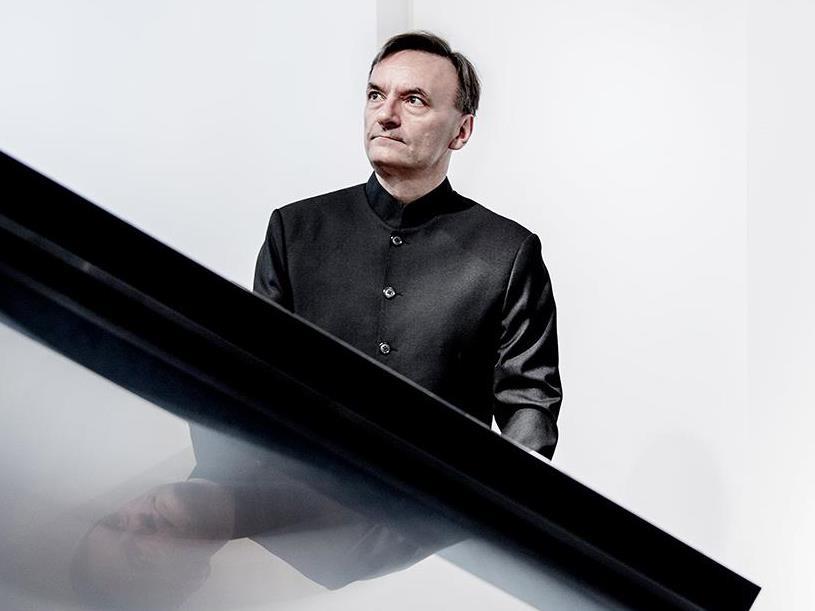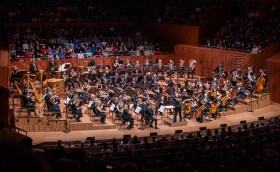Stephen Hough, piano. Image via SSO.
A large and enthusiastic audience, comprised mainly of school children, warmly greeted the Sydney Symphony Orchestra directed by Canadian conductor Julian Kuerti in his debut with the orchestra for this Meet the Music concert on Wednesday evening in the Sydney Opera House Concert Hall. Soloists for the performance were newly returned Australian operatic soprano Celeste Lazarenko performing with the orchestra for the first time and pianist Stephen Hough, a regular visitor to our concert stages. The program’s title alludes to a combination of the ‘sacred’ (Ross Edwards’s pantheistic Earth Spirit Songs – Symphony No 2 and Mendelssohn’s ebullient celebration of the Lutheran Reformation in his Symphony No 5 in D minor, Op 107) and the ‘secular’ of Rachmaninoff’s Satanic Rhapsody on a Theme of Paganini, Op 43.
We opened, however, with a celebration of Australian composer Ross Edwards’s 75th birthday (some five months early) with the composer looking somewhat overwhelmed onstage while the entire standing audience, accompanied by the SSO, sang Happy Birthday to You. The composer has had a long and strong association with this orchestra over several decades. His Maninyas – Concerto for Violin and Orchestra (1988), perhaps his best-known and most-often performed orchestral work, was commissioned to celebrate Australia’s bicentenary and was first performed in this same hall by the SSO with Dene Olding as soloist. His second Symphony for soprano and orchestra was composed between 1996 and 1997 for the SSO and Yvonne Kenny and, unusually for this composer who draws inspiration largely from the Australian landscape and its fauna, it was imagined during a walk on the shore of Lake Lucerne. Yet it comprises the usual combination of slow drones and low open parallel fifths juxtaposed with buoyant, intricately irregular dance music from his ‘Maninya’ style first conceived in 1981 with Maninya 1 for countertenor and piano. The work sets text from Christian Gregorian Chant (the Introit from the Mass of Pentecost), a sacred poem by the German medieval nun, composer and mystic Hildegard of Bingen and The Lost Man, a poem by Judith Wright allegorical of religious pilgrimage and sacrifice.
The SSO’s performance under Kuerti was good, particularly in the slow, grand and evocative sections of the initial Invocation and Dance of the Holy Spirit, with exquisite oboe solos from principal Diana Doherty, an artist closely associated with this composer’s music from Bird Spirit Dreaming – Concerto for Oboe and Orchestra (2002). The intricacies of the Maninyas fast music were dulled by the acoustic of this vast space, at least from where I was sitting. The music was certainly together, Kuerti’s direction efficient and precise, but it lacked exhilaration, polish of articulation and the sense of effortlessness that comes from a more closely studied familiarity with the work. Celeste Lazarenko’s is a warm and attractive soprano, her interpretation of the central lingering and lamenting of The Lost Man was moving, the deep strings acting as a kind of accompanying Orthodox chorus. The final Dance-Song to the Earth Mother, Hildegard’s poem alluding to verdure and fertility, evoked additional verve and vibrancy with excellent duets from concertmaster Andrew Haveron and assistant concertmaster Lerida Delbridge.
Rachmaninoff’s perennial favourite is a virtuosic tour de force that well suited the brilliant technique of the soloist, Stephen Hough. Throughout the variations of Paganini’s 24th Caprice he provided clear rhetoric, moving and tender expression and a dazzling dexterity. Rapport between soloist and orchestra was sharp as a tack throughout and balance very fine. All that was missing was a necessary depth and weight of Russian Romanticism, though the thrilling drive of the final reiterations of the plainchant Dies irae over the last two exhilarating variations compensated for this lack.The largely young audience, listening intently throughout, accorded the performance enthusiastic applause and were rewarded with an encore, By the Sleepy Lagoon by Eric Coates, originally a light orchestral waltz arranged by the soloist for piano.
Intended for the 300th anniversary celebrations of the Augsburg Confession leading to the establishment of the Lutheran Church, Mendelssohn’s fifth Symphony’s opening and closing movements are full of religious fervour, piety and exultation, the first quoting the ‘Dresden Amen’ and the latter based on the Lutheran hymn Ein feste Burg, while the inner two movements act more as divertissements, a typically brilliant Mendelssohnian scherzo and a heartfelt, song-like Andante. The orchestra’s expansive opening was well conveyed with perfectly voiced brass section.The following Allegro con fuoco had a powerful drive with nicely shaded phrasing though somehow, along with the finale, and despite best efforts, Kuerti was unable to lift the orchestra into any kind of exhilaration. The scherzo remained heavy throughout. The upper strings tenderly carried the Andante’s theme with ‘breathed’ phrases and some splendid, perfectly tuned flute contributions (Lisa Osmialowski, associate principal). More concerning was that in this enormous, wide space the ensemble had little focus of sound. The remedy for this fault may need to wait until the venue’s forthcoming renovations are complete.
Rating: 3 ½ stars ★★★☆
Spirit Realms – Sacred and Profane
Presented by Sydney Symphony Orchestra
Julian Kuerti, conductor
Stephen Hough, piano
4 July 2018
Sydney Opera House Concert Hall





